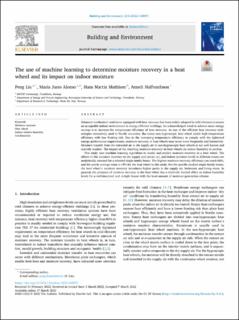| dc.description.abstract | Balanced mechanical ventilation equipped with heat recovery has been widely adopted in cold climates to ensure an acceptable indoor environment in energy-efficient buildings. An acknowledged trend to achieve more energy savings is to increase the temperature efficiency of heat recovery. As one of the efficient heat recovery technologies extensively used in Nordic countries, the rotary non-hygroscopic heat wheel yields high-temperature efficiency with low frosting risk. Due to the increasing temperature efficiency to comply with the tightened energy performance requirements, moisture recovery in heat wheels may occur more frequently and intensively. Moisture transfer from the extracted air to the supply air in non-hygroscopic heat wheels is not well known and scarcely studied. The impact of the resulting moisture recovery in heat wheels on indoor humidity is unclear. This study uses machine learning algorithms to model and predict moisture recovery in a heat wheel. The effects of this moisture recovery on the supply and extract air, and indoor moisture levels in different rooms are analytically assessed for a selected single family house. The highest moisture recovery efficiency can reach 68%, and the yearly average value is 19% for the heat wheel in this study. For the specific studied single-family house, the heat wheel's moisture recovery introduces higher peaks in the supply air, bedrooms and living room. In general, the presence of moisture recovery in the heat wheel has a relatively limited effect on indoor humidity levels for a well-insulated and airtight house with the least amount of moisture generation scheme. | en_US |

